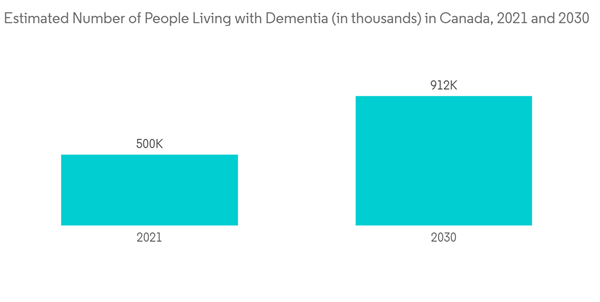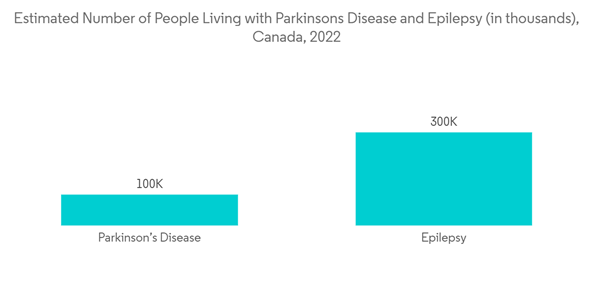The outbreak of COVID-19 impacted the market. The efficiency of nuclear imaging in COVID-19 diagnosis increased the use of nuclear imaging during the pandemic. Positron emission tomography (PET) or single-photon emission computed tomography (SPECT) can be used to identify the presence of inflammaation, fibrosis, changes in cardiac perfusion rate, renal excretion, and brain metabolism. The high detection sensitivity of PET and SPECT also facilitates the detection of new biological information during the initiation, progression, and evaluation of treatment for COVID-19. Thus, such high precision in detecting COVID-19 disease progression has increased the number of PET-CT units by 43.0% in Canada to combat the increasing demand for nuclear imaging, as per the Canadian Medical Imaging Inventory Service Report published in March 2022.
Key Highlights
- However, long wait times for nuclear imaging among the Canadian population during the pandemic had a slight adverse impact on the market. Thus, the market witnessed moderate growth during the pandemic. However, the increasing efforts to reduce the wait times for nuclear imaging and the rising number of SPET and PET units are expected to contribute to the market growth post-pandemic.
- The studied market growth can largely be attributed to factors such as the increasing prevalence of cancer and cardiac disorders, technological advancements, and product development. Moreover, the major players are undertaking various strategic initiatives to expand their market share. These include mergers, acquisitions, collaborations, partnerships, and product launches. For instance, in March 2021, Advanced Cyclotron Systems Inc. collaborated with the Canadian Nuclear Isotope Council (CNIC), further strengthening the industry association as the pre-eminent representative of the Canadian isotope sector.
- Similarly, in July 2021, Canada's Calgary announced to spend more than USD 18.0 million over the next three years to build Calgary's first cyclotron and a new radiopharmaceutical facility. With the onset of the initiative, Calgary will be able to create its reliable supply of radiopharmaceuticals, and these unique medications can be used to diagnose and treat a variety of cancers, bone diseases, strokes, epilepsy, and dementia. Thus, owing to such instances, considerable market growth is expected over the forecast period.
- Furthermore, in May 2021, the Canadian Association of Nuclear Medicine (CANM) unanimously adopted new procedure guidelines for brain single photon emission computed tomography (SPECT) imaging for psychiatry and neurology. The Canadian Association of Nuclear Medicine (CANM) has endorsed brain SPECT imaging for the assessment of attention deficit hyperactivity disorder (ADHD), bipolar disorder, depression, obsessive-compulsive disorder (OCD), posttraumatic stress disorder (PTSD), Alzheimer's disease, traumatic brain injury, substance abuse, and more.
- Similarly, in June 2021, Health Canada approved Eckert & Ziegler Radiopharma's GalliaPharm Ge68/Ga-68 generator for use with Advance Accelerator Applications' NETSpot kit for the localization of somatostatin receptor-positive neuroendocrine tumors (NET) in adult patients using Positron Emission Tomography (PET). Hence, owing to the above-mentioned factors, the market studied is expected to grow steadily over the forecast period.
- However, the shortage of radioisotopes and stringent regulations in Canada will likely hinder market growth over the forecast period.
Canada Nuclear Imaging Market Trends
Neurology Segment is Expected to Witness Considerable Growth Over the Forecast Period
- Neurological disorders are medically defined as disorders affecting the brain and nerves throughout the human body and spinal cord. Structural, biochemical, or electrical abnormalities in the brain, spinal cord, or other nerves can result in various symptoms.
- The common neurological disorders requiring nuclear imaging include intracranial tumors, dementia, Parkinson's disorders, and epilepsy. The factors leading to this segment's growth include the high burden of neurologic disorders, rising product approvals, and research studies of single-photon emission computed tomography (SPECT) in diagnosing neurological issues in Canada.
- The increasing number of neurological disorders in Canada is one of the major driving factors for market growth. For instance, according to the data from the Alzheimer Society of Canada 2021, over 500,000 Canadians were living with dementia, and by the year 2030, this number is expected to rise to 912,000.
- Furthermore, the data suggested that, on average, 9 senior citizens are diagnosed with dementia every hour in Canada. For people who are above 65 years of age, the risk of being diagnosed with dementia doubles every five years. The high burden of dementia in the Canadian population, especially among the elderly, is expected to boost the demand for better SPECT imaging. This is expected to increase segment growth during the forecast period.
- Furthermore, many developments in Canada include product launches and approvals, partnerships, collaborations, mergers, and acquisitions in the market for SPECT applications. For instance, in May 2021, the Canadian Association of Nuclear Medicine (CANM) authorized the use of brain single photon emission computed tomography (SPECT) imaging to evaluate many common neurologic and psychiatric indications, including Alzheimer's disease disorders. Therefore, owing to the increasing cases of neurological disorders and product approvals related to neurological disorders in Canada, considerable segment growth is anticipated over the forecast period.
SPECT Radioisotopes Segment is Expected to Witness Significant Growth Over the Forecast Period
- Single-photon emission computed tomography (SPECT) scan is an imaging test that shows how blood flows to tissues and organs. It can be used to diagnose seizures, strokes, stress fractures, infections, and tumors in the spine. The radioisotopes typically used in SPECT to label tracers are iodine-123, technetium-99m, xenon-133, thallium-201, and fluorine-18. These radioactive forms of natural elements will pass through the body and can be detected by the scanner. Various drugs and other chemicals can be labeled with these isotopes.
- The increasing number of cases of various diseases in Canada requiring SPECT imaging is one of the major drivers for the segment. For instance, according to the study published by the Alzheimer Society in 2022, more than 1.7 million Canadians are expected to be living with dementia, with an average of 685 individuals being diagnosed each day by the year 2050. Similarly, according to the report published by the Kids Brain Health Network in February 2023, 1 in 11 between the ages of 4 and 11 have a neuro disability, representing 9.15% of children in Canada.
- Single-photon emission computed tomography (SPECT) is a functional brain imaging procedure that allows physicians to measure functional changes in gray matter structures based on regional cerebral blood flow (rCBF). In addition, it can also be used as a diagnostic tool and a potential biomarker for monitoring and evaluating new treatments in patients with complex neuropsychiatric conditions.
- Recently, a study published by the National Center for Biotechnology Information (NCBI) in January 2022 demonstrated that SPECT imaging could provide the clinician with complementary insights into the underlying neurobiology to standard clinical assessments. Thus, such advancements may increase the use of SPECT imaging in diagnosing various diseases, propelling the use of SPECT radioisotopes in Canada.
Canada Nuclear Imaging Industry Overview
The nuclear imaging market is moderately competitive and has a few significant players. In terms of market share, few of the major players currently dominate the market. Companies like Bracco Imaging SpA, GE Healthcare, Canon Medical Systems, Koninklijke Philips NV, and Siemens Healthineers, among others, hold a substantial share of the market.Additional Benefits:
- The market estimate (ME) sheet in Excel format
- 3 months of analyst support
This product will be delivered within 2 business days.










